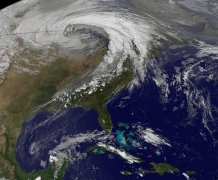Articles

Strong extratropical cyclones, like this one seen over the US Midwest, may be three times more common by the end of the century.
Image courtesy of NASA
Climate change could lead to threefold increase in storms that bring flooding to Europe and North America, research shows
Powerful storms that cause extreme weather conditions such as flooding across Europe and North America, with the potential to wreak social and economic havoc, could increase threefold by the end of the 21st century due to climate change.
Pioneering new research, led by Dr Matt Hawcroft from the University of Exeter, has shown new and detailed information on projections of the frequency of extratropical cyclones.
The research shows that unless there is a significant reduction in greenhouse gas emissions, there will be a stark increase in their frequency across large swathes of the Northern Hemisphere.
Crucially, the impact on local communities could be severe, with more intense and extreme storms leading to greater large-scale flooding events – similar to those experienced across Somerset in 2013/14, Cumbria in 2015 and Gloucestershire in 2007.
The research is published in the journal Environmental Research Letters on Tuesday, November 27 2018.
Dr Hawcroft, a Research Fellow in Exeter’s Mathematics department said: “It is expected that precipitation extremes will increase in intensity and frequency in a warmer climate. In this work, we have attributed those changes to the events which bring much of our large-scale rainfall and flooding. This additional information, on the dynamical nature of changes, is important since it provides clear information on the nature and impact of the changes in precipitation that can be used, for example, in policymaking and adaptation planning.”
Extratropical cyclones, which are steered by the jet stream, play a key role in day-to-day weather variability across large parts of North America and Europe. They are characterised by areas of low atmospheric pressure in the storm's centre, with air drawn cyclonically (anti-clockwise) around the low pressure.
This leads to warm air being drawn from the south and cold air from the north. At the interface of cold and warm air, fronts form which can induce heavy rainfall. The most extreme storms are responsible for much large-scale flooding in North America and Europe.
A key piece of information for policymakers and governments looking to mitigate against such extreme weather conditions is the ability to project where and how often these storms may occur in the future. However, current climate model projections are affected by huge uncertainties.
In this new study, the researchers analysed the behaviour of present day and future storms using state-of-the-art modelling and storm tracking techniques. By approaching the analysis in a ‘storm centred’ framework, the team were able to evaluate changes in the frequency and intensity of these extratropical cyclones with more consistency than previous studies have suggested.
Importantly, the research team were able to show that models project there would be a threefold increase in the number of the most intensely precipitating extratropical cyclones in both Europe and North America by the end of the century.
Dr Hawcroft added: “Due to the complexity of the circulation response to warming, there is much uncertainty in regional patterns of climate change. Given this uncertainty, it is important to be able to distil clear information where that is available. Here we show that in spite of these complexities, we are still able to provide large and consistent projections of change in these highly impactful events.”
Significantly increased extreme precipitation expected in Europe and North America from extratropical cyclones is published in Environmental Research Letters.
Date: 27 November 2018
